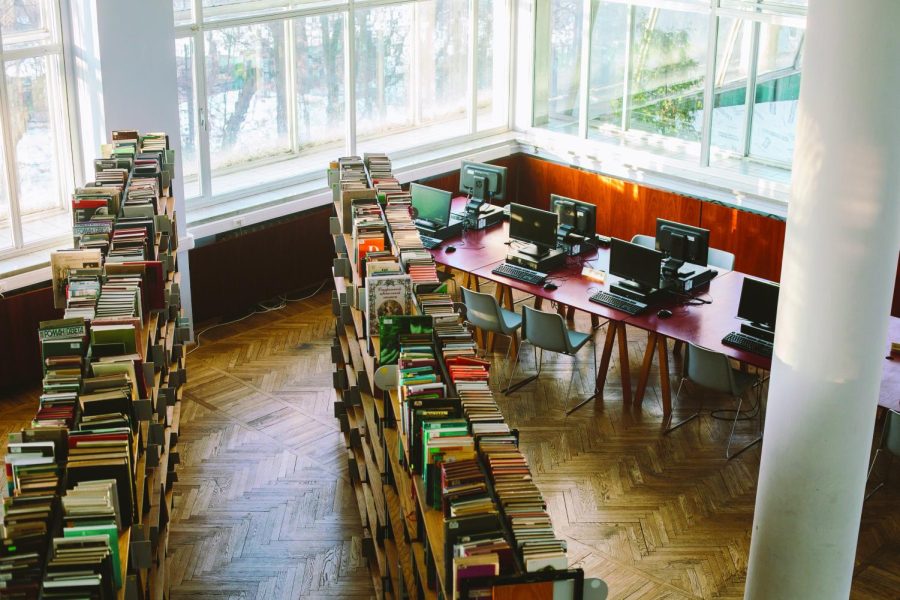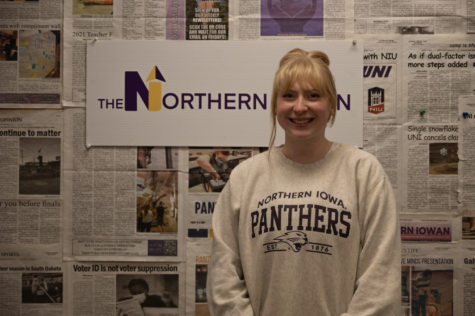Laptops versus desktops
As access to technology transitions rapidly, the usage of university computer labs has dwindled. Now, they are mainly used for printing or accessing special programs.
Jan 19, 2023
Computer labs have become relatively unused in favor of personal technology
For Emma Criswell, class starts with taking out her laptop and setting it in front of a university-sanctioned, relatively state-of-the-art, 24 inch Macbook monitor. And she isn’t the only one – most students nowadays whip out their personal devices for class.
Due to technological advances and more people owning their own devices, there has been a decline in use of computer labs campus wide. The IT department has taken note and is considering shifting away from using university funds to obtain and upkeep as many desktops on campus.
IT manages all UNI-owned computers across campus and maintains them for their lifetime. This includes applying security and updates, installing software, keeping hardware working and disposing of them appropriately when no longer of use. Ben Arnold, director of Client Services for IT, says that there have been concerns with the way computer labs function as of now. Arnold stated, “Students want to use the technology or software from where they want to be at (instead of a specific computer lab space). They’d rather have the software they need on their device or access to it from their device and be able to study where they want to study.
There is no doubt that computer labs are necessary on campus, but there is some concern if the amount of labs are being used enough to warrant their prevalence. As a Digital Media Production major, a majority of Criswell’s classes take place in computer labs in Lang Hall. So, why aren’t students using computer lab monitors?
Between spending too much time logging in, pulling assignments up and DUO push notifications, many have decided it’s more convenient to use their laptops. In fact she says they can actually be distracting as some classes are set up in a way that make it hard to see the projector because of such large monitors. She says, “Personally, I have never even turned on the computer while being in that class because I have a laptop and I think everyone else in the class does.”
That isn’t always the case, however. Although a majority of students have their own devices, many do not have the ability to afford a laptop, much less one that will last four years. This is the first year that Rod Library has given the option of free laptop rentals for a full semester in addition to the other two checkouts for three hours and two weeks. Criswell says, “We could put more money into giving out more nice rental computers versus computers in classes that not many people use.”
The pandemic rapidly shifted how we use technology at the university level. Macey Reed, a fifth year student, said, “Before COVID, there were computer labs in most dorms – there were a lot more computers on campus in general.” As a freshman, she often made use of her dorm lab, especially if she needed to work together with her roommate who did not have a laptop at the time. When classes shifted to remote learning, there was an increased pressure to ensure all students had computers at home as well as stable internet connection. When students returned to campus, computer lab numbers had been significantly cut and removed from dorms.
However, Reed says that isn’t an issue. The hours she spent in labs as a first year has dwindled down to about 30 minutes a week. Now, she primarily uses labs for special features within the art program or printing.
In fact, campus-wide computer labs are used the most for printing. Across all student interviews, everyone reported that they need computer labs the most for printing services, although there is a relatively new option for mobile printing. Arnold says, “We’ve expanded our print management system to allow students to print from their own personal devices and not have to rely on computer lab computers for their only mechanism to print.” This shift came after students complained about having to log in to a new device so often. Although DUO push is an important last line of defense against personal student data, it certainly is a pain to deal with. Criswell says, “I log in with my ID, I have to log into MyUniverse, I have to log in so many times and get approved. On my laptop, it isn’t like that because I am already logged in.”
Criswell used the lab in Redeker for all of her printing needs while living on campus; she says it was very convenient to walk past a lab on her way to class. Now, Criswell highlights how beneficial the new student lounge on the third floor of Lang is. Many communication and digital media students use that as their everyday printer or as an easily accessible last resort before class.
Despite personal laptops being the preference for many students, there are specific needs that computer labs cater for. Reed works as a student employee at both the IT service desk and library. She notes on some of the issues she notices in her jobs, primarily in concern of readily available software programs.
“I know that business majors will come into the library because there is one computer in the library that has a program that they are required to use for a certain class (Intermediate Finance).” If there are issues with that specific computer it causes a problem for students and employees.
Another unique perspective Reed provides is that of an art major. Especially within graphic design, she says students have to use Mac computers for their Adobe features. If students do not have their own laptop or one that isn’t as compatible with Adobe, they have to go to a computer lab. Although there are a few Mac desktops on the main level of Rod they do not have any Mac laptops to check out. Adobe Suite also may not be on the most updated version and can complicate assignments.
The things students want computer labs to have are up to date applications in addition to specific programming. Grant Wulfseng, an accounting graduate student, says he appreciates the computers in the library. “I like them for group projects where we can have two monitors with an Excel spreadsheet with instructions,” he says. In regards to the future of campus technology Wulfseng would like to see, more shifts to update the library and obtain more bluetooth opportunities.
IT is working as hard as they can to maintain the balance between accessible technology and being current. “Technology is always evolving, and we try to stay as current as we can. You don’t want to be on the bleeding edge of technology either, as that can lead to problems or pain points,” Arnold says. “When we think of the future of technology, we think about continuing to deliver services to students, faculty, and staff that add value and help them be successful in their missions of learning or teaching.”









